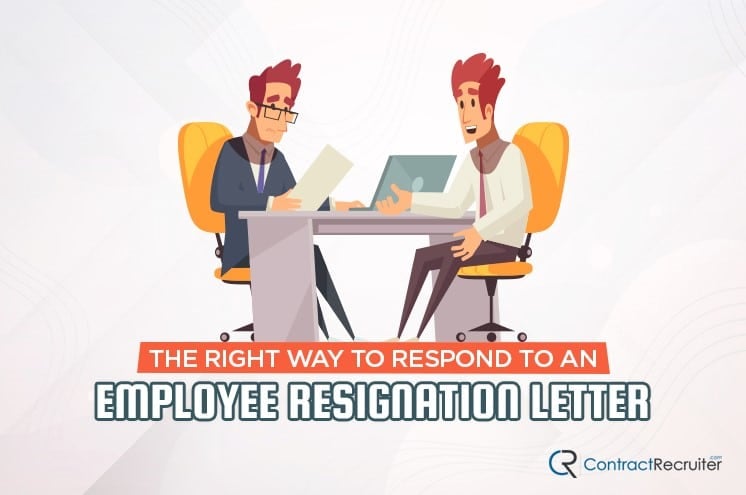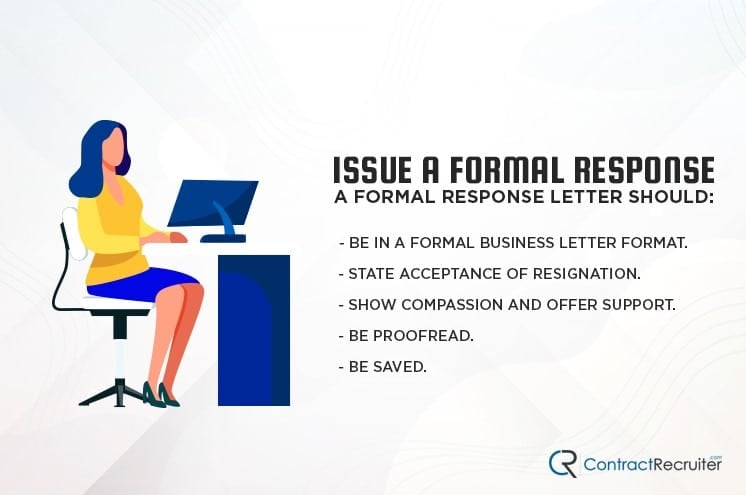

An employee leaving is rarely a cause for celebration. The days of 50-year careers and retirement celebrations are over, and these events are a rarity. Today, when employees leave, they’re likely doing so because they have another, better job lined up.
This kind of turnover can be both annoying and costly. Not only are you losing an employee, but you may also already be short-staffed, you may be in the middle of a high-volume time of year, or they may be a star employee. Their loss will be felt, not just in their team or your overall productivity, but your bottom line as well.
When all of this is weighing down on your mind, it can be easy to forget some of the common courtesies necessary to let an employee leave with grace and goodwill. One such courtesy is responding to a letter of resignation. Whether you’ve forgotten to do so or aren’t sure how to respond appropriately, let’s discuss the issue.
Determine the Context
An employee leaving with a letter of resignation is generally one of the better outcomes, believe it or not. When the alternative is an on-the-spot “I quit!” leaving you in a tight spot, having the advance notice of a resignation letter is a great position to be in. However, you still likely want to analyze the situation to determine the next steps.
First, look into the reason why the employee is choosing to leave. Generally, these reasons can get divided into two groups: those you can refute and those you can’t.
For example, if an employee has a family emergency and they will not be able to continue working indefinitely – such as becoming a caregiver for a parent or spouse – there’s not much you can necessarily do to keep them around.


On the other hand, situations such as:
- The employee is pursuing other opportunities to advance their career.
- The employee is moving across the country for a spouse’s job.
- The employee is no longer satisfied with your benefits package.
These can be refuted. In particular, you can consider offering additional perks and benefits to keep the employee on board. Addressing the three complaints above, you can:
- Offer a defined track for a promotion, raise, or increase in title and duties.
- Offer the option to work remotely.
- Offer an increase in benefits.
For an excellent employee, taking action to keep them around may be enough to convince them to change their mind. Often, employees don’t necessarily want to leave; they want stability and a long-term career. Unfortunately, stagnation in the workforce often means career paths don’t exist the way they used to. Sometimes, the only way an individual can advance is to take a new position with a different company.
Sometimes, the employee is leaving for a reason that can be addressed, but that is unlikely to be. For example, if they have an ongoing feud with a manager, terminating that manager could keep them around. Similarly, a workplace culture they find toxic can get adjusted. However, these are major shifts, and many employers are unlikely to make those shifts for a single employee.
Establish a Timeline
The traditional timeline for an employee leaving is a two weeks’ notice. This time frame gives the employer some time to begin transitioning duties to other employees, begin seeking a replacement, and take other relevant actions such as handling all of the paperwork, paying out remaining benefits, and handling a transfer of insurance coverage.


Sometimes, the employee may give more or less notice. Two weeks is standard, but it is not required in any jurisdiction.
“There are no federal or state laws that require an employee to provide two weeks’ notice to his or her employer before quitting. […] all states except Montana have adopted the at-will rule, which is a common-law doctrine that defines most employment relationships. Excluding exceptions, the at-will doctrine gives an employer the right to terminate an employee at any time, without cause or any reason. Likewise, employees are also allowed to leave their employment at any time and without reason. Thus, neither the employer nor the employee is required to give the other any notice that the employment relationship will end.” – Employment Law Handbook.
The two weeks’ notice may be written into the employment contract. In this case, if the employee leaves with less notice, you could potentially pursue them for a breach of contract. In practice, this is virtually never worth the effort and expense.
In some cases, the employee may give a longer notice, stating their intention to leave at a given date in the future. This additional notice is beneficial to you, as it gives you more time to handle the transfer. It’s not typical, and you should not expect it, however.
Your first goal should be establishing a timeline based on how much notice you have. It’s essential to recognize that this is unlikely to be “business as usual” for the employee up until their last day. Instead, this time should be used to transfer institutional knowledge, add to a knowledge base, transfer accounts and duties, train a replacement, and handle whatever other tasks need handling to ensure a smooth transfer.
Ideally, of course, you should have enough employees on hand that you can promote someone else to take the spot, but many companies operate on short staffing these days, so this may not be possible. Do the best you can to distribute duties temporarily and record institutional knowledge while searching for a replacement.
Issue a Formal Response
A formal letter of resignation usually requires a formal response. This formal response is the first step in the paperwork that must be completed to end the employment contract of the departing employee.


A formal response letter should:
- Be in a formal business letter format. This letter is not a casual agreement, and your response may be considered part of evidence or discussions down the line, particularly if there’s ever a legal disagreement.
- State acceptance of resignation. Typically, the first paragraph will include an acknowledgment of the employee’s intent to leave, as well as a statement of their intended final day.
- Show compassion and offer support. This inclusion is the most customized part of the letter. It should express professional sentiments that you are sad to see them go and offer them support in their future endeavors, including being a reference for future job searching. Of course, this should be tailored to the relationship and circumstances you have with the departing employee.
- Be proofread. Nothing is worse than immortalizing a typo or poor turn of phrase in a formal letter that will be filed away and kept for years to come.
- Be saved. The employee’s letter of resignation, and your response, should be held in their file with HR for a relevant duration. These records should be kept in case disputes arise later.
There are many options for formal letters. Some companies issue them as a matter of course and as part of their procedure. Others consider it more or less a formality, while everything else gets handled in a more casual, verbal, in-person manner. It also depends on the relationship between the company, HR, their manager, and the employee. If there’s antagonism or ill will, the process may be insulated behind formality. If it’s all casual and friendly, the letter may be little more than record-keeping.
For examples of letters and templates you can use, check:
- Linguaholic’s analysis of resignation receipt letters and responses.
- Indeed’s analysis and template versions of response letters.
- Sample letters from MyCareersFuture.
- An example letter from GreatSampleResume.
Your letter may or may not contain an attempt to bargain to keep the employee around. Again, this may depend on your relationship with your employee and their reason for leaving. Offering a counter-offer, promotion, or another package to retain the employee may be able to change their mind and keep them around.
Be aware that employee retention is a tricky issue. If an employee expresses their intent to leave and you give them a counter-offer to stay that they accept, this sets a precedent. Other employees may use this as leverage to ask for increases of their own, which can trigger either a wave of demands or a wave of resignations. Situations like this are why retention is challenging to navigate.
Include and Proceed with the Next Steps
Once you have accepted the letter of resignation, you need to begin the transfer of knowledge and duties immediately. Your employee had work to do, but they will no longer necessarily be doing it. Their duties need to get assigned to other employees who can handle them temporarily, or another employee needs to get promoted to assume those duties, and their duties distributed, and so on. Sometimes this is easy with a simple division of labor amongst an existing team. Sometimes it’s a cascade of changing responsibilities that results in restructuring the department.


Behind the scenes, as far as the employee is concerned, you need to begin hiring a replacement, either for the employee or for the person promoted to replace the employee. Depending on your hiring process, you may need to start from scratch or have a pool of hot leads ready to be contacted for an interview or offer.
Ideally, the timeline provided and the structure you have established within HR will allow you to handle the transition smoothly.
What Not to Do
Reacting inappropriately to a letter of resignation can have disastrous consequences for your business. Depending on how you react, it might:
- Spur other employees to demand compensation or leave.
- Damage your employer brand and reputation for future employees.
- Damage your ability to smoothly transition to a new employee.
- Breach a contract or violate behavioral policies and lead to punishment or legal action.
Thus, it’s not enough to know what you should do. You should also know what you should avoid.
Don’t take it personally.
In some cases, you are the reason the employee is leaving. Most of the time, even if this is the case, they will act professionally and won’t state that as the reason. Regardless of whether or not it’s true, please don’t assume it is or act like it is.


Reacting personally or acting defensively is a natural response to an adverse event, but you have to resist it. Employees come and go; it’s part of doing business. Remind yourself of this fact.
Don’t argue or berate the employee.
“You can’t quit; you’re fired!” is not an appropriate response. Reacting with anger, bargaining, or attempting to argue that the reasons they’re leaving are not valid will only create ill will between them and your company.


Worse, it can spread to other employees and even to candidates beyond your office walls, and that sort of reaction can have long-reaching repercussions.
Don’t express relief or happiness.
Even if, realistically, you’re glad to see them leave, don’t let anyone know.
“Do not–ever–immediately tell every other employee how relieved you are that the departing employee is departing. Don’t do it in one-on-ones, or even if you have a great relationship outside of work. It makes you look unprofessional and will make the other employees wonder whether you’re harboring similar thoughts about them and their performance. Even if you are positively bursting with glee that the departing employee is leaving, wait until you’re with your partner or a non-work friend to revel in your delight.” – Zippia.
If you follow all of these precautions, you’re much more likely to ensure a positive relationship with your former employee, which can lead to referrals for new candidates in the future, as well as a generally more positive employer brand. Sooner or later, it’s a situation you’ll need to deal with. Learning how to handle it well is an essential skill as an employer.


If, after reading, you have any questions or additional concerns regarding responding to an employee resignation letter, please feel free to leave a comment down below, and we’ll get a conversation started. It can be a tricky situation to navigate, so we’ll gladly clear up any of those concerns that you may have.


